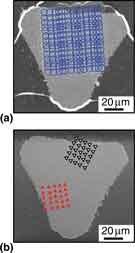Crossref Citations
This article has been cited by the following publications. This list is generated based on data provided by
Crossref.
Kunitake, Miki E.
Mangano, Lauren M.
Peloquin, John M.
Baker, Shefford P.
and
Estroff, Lara A.
2013.
Evaluation of strengthening mechanisms in calcite single crystals from mollusk shells.
Acta Biomaterialia,
Vol. 9,
Issue. 2,
p.
5353.
Kunitake, Miki E.
Baker, Shefford P.
and
Estroff, Lara A.
2013.
Erratum to: The Effect of Magnesium Substitution on the Hardness of Synthetic and Biogenic Calcite–CORRIGENDUM/ERRATUM.
MRS Communications,
Vol. 3,
Issue. 1,
p.
79.
Liu, Yujing
Chen, Liao
Liu, Wei
Ye, Tao
Chen, Hongzheng
and
Li, Hanying
2014.
Synthetic polymer/single‐crystal composite.
Polymers for Advanced Technologies,
Vol. 25,
Issue. 11,
p.
1189.
Long, Xia
Ma, Yurong
and
Qi, Limin
2014.
Biogenic and synthetic high magnesium calcite – A review.
Journal of Structural Biology,
Vol. 185,
Issue. 1,
p.
1.
Schenk, Anna S.
and
Kim, Yi-Yeoun
2015.
Unraveling the internal microstructure of biogenic and bioinspired calcite single crystals.
MRS Bulletin,
Vol. 40,
Issue. 6,
p.
499.
Nakouzi, Elias
Rendina, Ryan
Palui, Goutam
and
Steinbock, Oliver
2016.
Effect of inorganic additives on the growth of silica–carbonate biomorphs.
Journal of Crystal Growth,
Vol. 452,
Issue. ,
p.
166.
Kim, Yi‐Yeoun
Semsarilar, Mona
Carloni, Joseph D.
Cho, Kang Rae
Kulak, Alexander N.
Polishchuk, Iryna
Hendley, Coit T.
Smeets, Paul J. M.
Fielding, Lee A.
Pokroy, Boaz
Tang, Chiu C.
Estroff, Lara A.
Baker, Shefford P.
Armes, Steven P.
and
Meldrum, Fiona C.
2016.
Structure and Properties of Nanocomposites Formed by the Occlusion of Block Copolymer Worms and Vesicles Within Calcite Crystals.
Advanced Functional Materials,
Vol. 26,
Issue. 9,
p.
1382.
Yang, Heng
Chai, Shiqiang
Zhang, Yuzhe
and
Ma, Yurong
2016.
A study on the influence of sodium carbonate concentration on the synthesis of high Mg calcites.
CrystEngComm,
Vol. 18,
Issue. 1,
p.
157.
Zhang, Yuzhe
Chai, Shiqiang
Ma, Yurong
and
Qi, Limin
2016.
Investigations on the microstructures of sea urchin spines via selective dissolution.
CrystEngComm,
Vol. 18,
Issue. 48,
p.
9374.
Ragazzola, F.
Foster, L. C.
Jones, C. J.
Scott, T. B.
Fietzke, J.
Kilburn, M. R.
and
Schmidt, D. N.
2016.
Impact of high CO2 on the geochemistry of the coralline algae Lithothamnion glaciale.
Scientific Reports,
Vol. 6,
Issue. 1,
Kim, Yi-Yeoun
Carloni, Joseph D.
Demarchi, Beatrice
Sparks, David
Reid, David G.
Kunitake, Miki E.
Tang, Chiu C.
Duer, Melinda J.
Freeman, Colin L.
Pokroy, Boaz
Penkman, Kirsty
Harding, John H.
Estroff, Lara A.
Baker, Shefford P.
and
Meldrum, Fiona C.
2016.
Tuning hardness in calcite by incorporation of amino acids.
Nature Materials,
Vol. 15,
Issue. 8,
p.
903.
Iglikowska, A.
Najorka, J.
Voronkov, A.
Chełchowski, M.
and
Kukliński, P.
2017.
Variability in magnesium content in Arctic echinoderm skeletons.
Marine Environmental Research,
Vol. 129,
Issue. ,
p.
207.
Coffey, William D.
Nardone, Jessica A.
Yarram, Aparna
Long, W. Christopher
Swiney, Katherine M.
Foy, Robert J.
and
Dickinson, Gary H.
2017.
Ocean acidification leads to altered micromechanical properties of the mineralized cuticle in juvenile red and blue king crabs.
Journal of Experimental Marine Biology and Ecology,
Vol. 495,
Issue. ,
p.
1.
Ye, Tao
Jin, Xin-Yi
Chen, Liao
Hu, Chong
Ren, Jie
Liu, Yu-Jing
Wu, Gang
Chen, Lu-Jian
Chen, Hong-Zheng
and
Li, Han-Ying
2017.
Shape change of calcite single crystals to accommodate interfacial curvature: Crystallization in presence of Mg 2+ ions and agarose gel-networks.
Chinese Chemical Letters,
Vol. 28,
Issue. 4,
p.
857.
Kabacińska, Z.
Yate, L.
Wencka, M.
Krzyminiewski, R.
Tadyszak, K.
and
Coy, E.
2017.
Nanoscale Effects of Radiation (UV, X-ray, and γ) on Calcite Surfaces: Implications for its Mechanical and Physico-Chemical Properties.
The Journal of Physical Chemistry C,
Vol. 121,
Issue. 24,
p.
13357.
Whittaker, Michael L.
and
Joester, Derk
2017.
ACBC to Balcite: Bioinspired Synthesis of a Highly Substituted High‐Temperature Phase from an Amorphous Precursor.
Advanced Materials,
Vol. 29,
Issue. 26,
Tansman, Gil F.
Kindstedt, Paul S.
and
Hughes, John M.
2017.
Crystallization and demineralization phenomena in washed-rind cheese.
Journal of Dairy Science,
Vol. 100,
Issue. 11,
p.
8694.
Cusack, Maggie
Chung, Peter
Zhu, Wenzhong
and
Endo, Kazuyoshi
2018.
Tuning of Calcite Crystallographic Orientation to Support Brachiopod Lophophore.
Advanced Engineering Materials,
Vol. 20,
Issue. 9,
Seknazi, Eva
and
Pokroy, Boaz
2018.
Residual Strain and Stress in Biocrystals.
Advanced Materials,
Vol. 30,
Issue. 41,
Nardone, Jessica A.
Patel, Shrey
Siegel, Kyle R.
Tedesco, Dana
McNicholl, Conall G.
O’Malley, Jessica
Herrick, Jack
Metzler, Rebecca A.
Orihuela, Beatriz
Rittschof, Daniel
and
Dickinson, Gary H.
2018.
Assessing the Impacts of Ocean Acidification on Adhesion and Shell Formation in the Barnacle Amphibalanus amphitrite.
Frontiers in Marine Science,
Vol. 5,
Issue. ,
